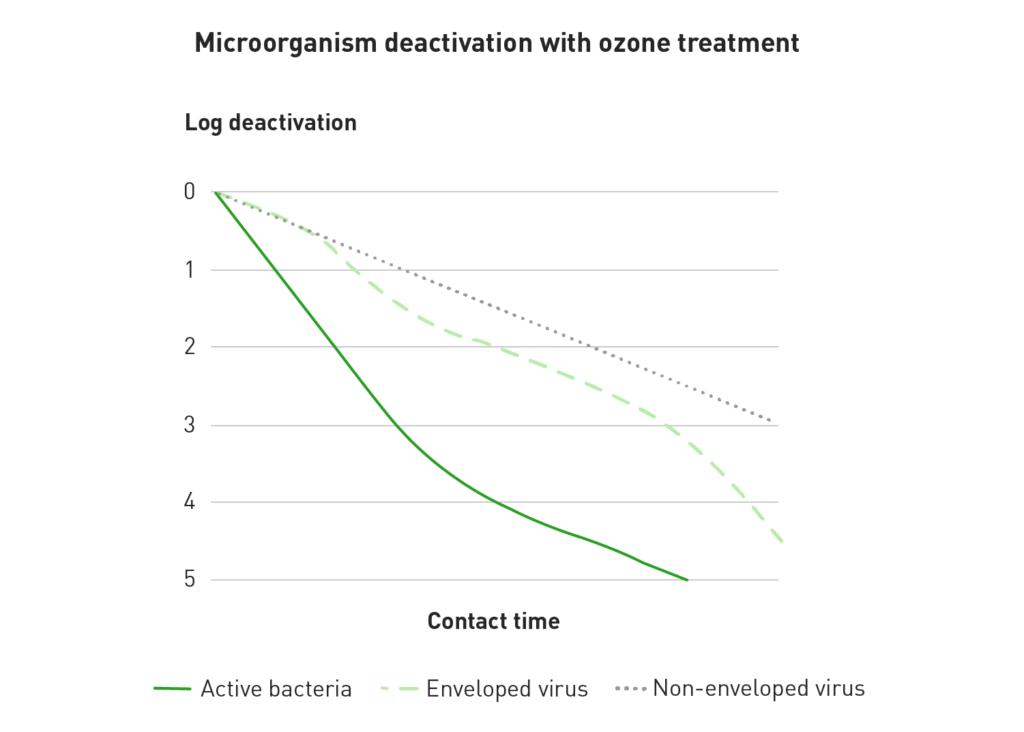Air & surface disinfection
Efficient solution for air and surface disinfection
Microorganisms cause issues in various places, in a clinical setting bacteria can cause dangerous outbreaks. Ozone can be used as a chemical disinfectant to kill bacteria and viruses with low ozone concentrations.
The contact time is altered depending on the desired deactivation grade as seen in the figure below:

Average trends for pathogen removal with ozone treatment.
For many applications a bacteria reduction of 99.99 % which corresponds to a 4 log reduction is sufficient, for a higher deactivation grade the solution is easily adapted to provide higher concentrations and exposure time, in adapted solutions even bacteria spores can be treated. The figure above applies for treatment in rooms and ventilation ducts, we have used ozone to limit the spread of airborne microorganisms in food industries and food storage.
Air disinfection in the food industry
In food applications the migration of microorganism inside the plant speed up molding, but with gentle ozone treatment the molding process is easily postponed for several days without damaging the food. Furthermore, in the dairy (external site) industry equipment has been sanitized using ozone which perform well and eliminates the need for more harmful chemical disinfectants.

Ozone treating strawberries can double shelf life
Air disinfection in hospitals and health facilities
In contrast to the food industry where rooms are often not treated at all, hospitals have high cleanness requirements and already employs frequent cleaning to reduce the spread of pathogens, this is commonly done by frequent wiping of surfaces with chemical disinfectants. Although this traditional method is effective, it has been shown that traditional manual cleaning and disinfection practices are often suboptimal. Reasons for failed cleaning can be due to misunderstandings, deviations from cleaning protocol, not wiping all surfaces, incorrect dilution of cleaning agent either by dilution machine or people and cleaning equipment surface structure being ineffective on certain materials. In a hospital setting such discrepancies increases the risk of pathogen spreading between areas and patients. Automated non-touch technologies are good additions to cleaning practices as it adds another layer of cleaning. (Boyce, 2016)
Different treatment methods
Non-touch technologies include the usage of UV-lamps and chemicals dispersed as an aerosol or gas which deactivates microorganisms. Compared to other treatment methods for air disinfection, ozone can efficiently disinfect large air volumes, neutralizing micro-organisms, including viruses. This makes it ideal for use in medical applications, for example in hospitals or doctors waiting rooms. An important factor that enables savings is the time the cleaning agent can actively deactivate bacteria, as compared in the figure below:

The chart show that the contact times varies greatly, UV cleaning systems often have a very short time window to irradiate the air and therefore needs to add a lot of energy to ensure sufficient deactivation in this short time, wiping with a cleaning solution is limited by the time it takes for the surface to dry while ozone will continue to attack bacteria until it naturally decomposes or is removed. This enables ozone solutions to increase energy saving significantly.
Ozone is produced on spot when needed thus eliminating extra resources required for handling and storing hazardous chemicals. Furthermore, no chemical residue remains after treatment as ozone naturally decomposes to oxygen.
In terms of usage, distribution as a gas enables ozone to reach hard to sanitize surfaces, reaching spots difficult to wipe. Studies has shown that low ozone concentrations are capable of deactivating bacteria and enveloped viruses by reacting with unsaturated fatty acids in the plasma membrane, certain surface proteins and DNA. However, for dealing with stable viruses and bacteria spores higher concentrations of ozone together with air moisture is required over several hours.
Read more about our RENA Pro Ozone Systems or download our brochure.
Reduce risk of spreading pathogens
In a clinical setting ozone generators can reduce the risk of pathogens spreading when new patients enters previously occupied rooms, it can also be used after traditional cleaning to reduce the risk of disease spreading from infectious body fluid left by the previous patient.
Depending on customer need the treatment time and ozone concentration is adapted to the desired log reduction as demonstrated in the figure below. After finished treatment ozone either decompose into oxygen naturally over several hours or the decomposition is accelerated significantly by the use of ozone destructors.
For clinics that are closed during the night, ozone treatment can be scheduled in waiting rooms, corridors and bathrooms giving plenty of time for treatment and ozone destruction before the first employee enters.
For surgery rooms or other areas that need a 6 log scale deactivation of bacteria, viruses and even spores, specialized solutions using high concentrations of ozone in a sealed room over several hours is necessary. The sanitation process can be started from a panel outside the room, and information regarding remaining time is displayed. Once the set time is over, the ozone is destroyed with an ozone destructor.
Contact us to tailor a solution for your disinfection needs.

